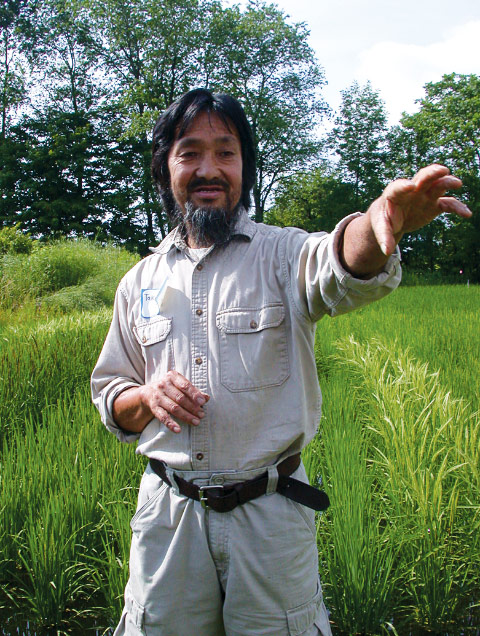Rice Is Nice
 |
|
To construct a 6-inch deep paddy, Takeshi Akaogi removed the topsoil to the hardpan, graded the land, and returned the soil. He applies composted chicken manure for nitrogen, which is essential to growth. Photo by Carrie Koplinka-Loehr |
...Especially When Locally Grown
Rice paddies in Vermont? At 900 feet above sea level? More than 40 skeptics and believers from New England and New York flocked to Earthbridge Farm last July to see, touch, and learn about cold-tolerant varieties at the Sustainable Rice Production for the Northeast workshop.
Rice, a grass known botanically as Oryza sativa, is a tropical plant that has been adapted to temperate areas of the world, such as northern China, northern Italy, Poland, Russia, and Hokkaido, Japan. Until two years ago, paddy rice hadn’t been successfully grown in parts of New England where the last frost occurs in May and the first frost in mid-September. So why the interest now?
Rice production is alluring both to locavores and to growers seeking ways to get production from marginal lands. The paddies diversify the landscape, attracting amphibians, water birds, and beneficial insects, and they buffer nearby wetlands. Most of all, a one-acre paddy will typically yield 2–4 tons of rice, more than twice the average yield of nonirrigated wheat.
So what do you need to grow rice? Sunshine, a reliable source of water, and a soil that will hold it. Takeshi and Linda Akaogi had all three.
In 2006, with assistance from the Natural Resources Conservation Service (NRCS), the Akaogis constructed a small rice paddy at their diversified farm in Putney, Vermont. The first year the plants grew well but didn’t produce seed. In 2007 they added two paddies (increasing production to 1/10 of an acre) and received a grant from Northeast Sustainable Agriculture Research and Education (NE-SARE) to determine if rice could be grown commercially. They identified 25 temperate varieties, many from Hokkaido, that produced seed. In 2008 they planted and studied three varieties, which yielded an average of 5,847 pounds of rice per acre.
Now the Akaogis are spreading the word. In the past two years they’ve hosted a series of workshops showcasing their rice paddies and their partners, such as rice breeders from Cornell, NRCS personnel, and Extension educators. Growers from surrounding states come to see the proof that rice can be grown productively in the Northeast and has the potential to become a commercial crop.
— by CARRIE KOPLINKA-LOEHR
The Northeastern IPM Center promotes integrated pest management for reducing risks to human health and the environment. If republishing our news, please acknowledge the source (“From Northeast IPM Insights”) along with a link to our website.
